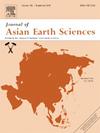青藏高原岩石圈东南挤压掘出的历史与机制
IF 2.7
3区 地球科学
Q2 GEOSCIENCES, MULTIDISCIPLINARY
引用次数: 0
摘要
在印度-亚洲碰撞中,高原岩石圈何时以及如何开始东南扩张并引发青藏高原东南部的快速隆升和掘出一直存在争议。本文对青藏高原东南部怒江构造带花岗岩进行了锆石U-Pb、云母Ar-Ar、磷灰石(U-Th)/He和裂变径迹年龄的测定,并进行了运动学观测。综合分析认为,45 ~ 40 Ma期间,青藏高原东南缘岩石圈扩张和东南缘构造格架的建立诱发了最早的剪切走滑脉冲。此外,青藏高原东南部在早中新世至上新世期间,从南到北经历了差异挤压和隆升。综合分析表明,青藏高原东南缘的南缘和北缘(约26°N)分别在中新世中期和上新世停止生长。该研究为青藏高原东南部新生代以来高原岩石圈的东南扩张过程和挖掘机制提供了迄今为止最详细的解析。本文章由计算机程序翻译,如有差异,请以英文原文为准。
The history and mechanism of southeastward extrusion and exhumation of the Tibetan Plateau lithosphere
When and how the plateau lithosphere commenced to expand southeastwards and then induced the fast uplift and exhumation in the SE Tibetan Plateau during the India − Asia collision remain controversial. Here we present zircon U-Pb, mica Ar-Ar, and apatite (U-Th)/He and fission track ages of the granites together with kinematic observations in the Nujiang tectonic zone of the SE Tibetan Plateau. An integrated analysis indicates the earliest pulse of shearing strike slip induced by the southeastward lithospheric expansion in the SE Tibetan Plateau and the establishment of tectonic framework of the SE Tibetan Plateau during 45 − 40 Ma. In addition, the SE Tibetan Plateau, from south to north, had experienced the differential extrusion and uplift during the early Miocene to Pliocene. An integrated analysis suggests that the south and north SE Tibetan Plateau (the boundary line at ca. 26°N) stopped growth at Middle Miocene and Pliocene, respectively. This study provides the most detailed resolution for the southeastward expanding processes of the plateau lithosphere and the exhumation mechanisms of the SE Tibetan Plateau during Cenozoic times to date.
求助全文
通过发布文献求助,成功后即可免费获取论文全文。
去求助
来源期刊

Journal of Asian Earth Sciences
地学-地球科学综合
CiteScore
5.90
自引率
10.00%
发文量
324
审稿时长
71 days
期刊介绍:
Journal of Asian Earth Sciences has an open access mirror journal Journal of Asian Earth Sciences: X, sharing the same aims and scope, editorial team, submission system and rigorous peer review.
The Journal of Asian Earth Sciences is an international interdisciplinary journal devoted to all aspects of research related to the solid Earth Sciences of Asia. The Journal publishes high quality, peer-reviewed scientific papers on the regional geology, tectonics, geochemistry and geophysics of Asia. It will be devoted primarily to research papers but short communications relating to new developments of broad interest, reviews and book reviews will also be included. Papers must have international appeal and should present work of more than local significance.
The scope includes deep processes of the Asian continent and its adjacent oceans; seismology and earthquakes; orogeny, magmatism, metamorphism and volcanism; growth, deformation and destruction of the Asian crust; crust-mantle interaction; evolution of life (early life, biostratigraphy, biogeography and mass-extinction); fluids, fluxes and reservoirs of mineral and energy resources; surface processes (weathering, erosion, transport and deposition of sediments) and resulting geomorphology; and the response of the Earth to global climate change as viewed within the Asian continent and surrounding oceans.
 求助内容:
求助内容: 应助结果提醒方式:
应助结果提醒方式:


